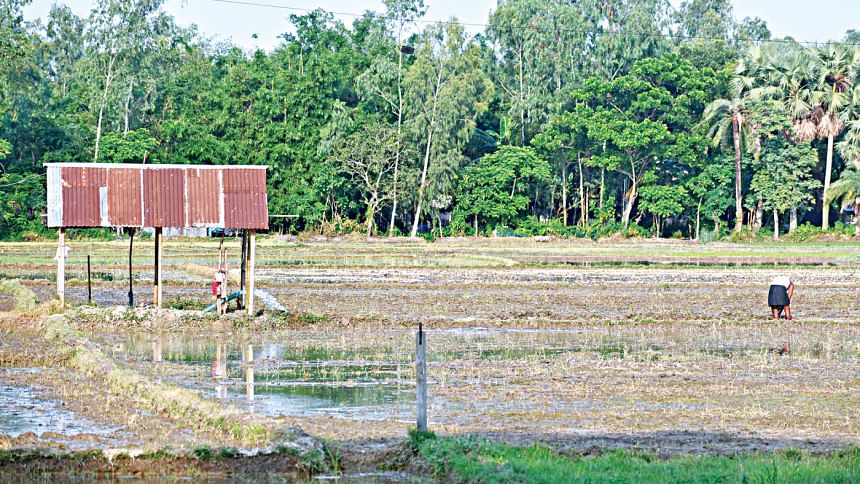El Niño weighs on Bangladesh’s agriculture

Extreme heat has gripped many parts of the world as June saw the warmest global average temperature on record and the trend continued into July, according to the UN's World Meteorological Organisation (WMO).
Bangladesh, as a country in the eastern and northern hemispheres, also witnessed heatwaves in May and June.
The country saw 16 per cent below normal rainfall in June and it is likely to see lower-than-usual precipitation this month as well.
As of the middle of this month, rainfall was 67 per cent below the normal level, said the Bangladesh Meteorological Department (BMD).
Extreme weather events are already affecting the agriculture sector of Bangladesh.
In early May, heatwaves and a drought-like situation impacted the cultivation of Aus crop and summer vegetables, including green chili, said farmers and agricultural scientists.
Since there has been inadequate rain this year, this is also going to affect the retting of jute, one of the cash crops.
The extreme weather events in Bangladesh are taking place at a time when the whole world has entered into a new phase of El Niño, a climate pattern associated with the warming of the ocean surface temperatures in the central and eastern tropical Pacific Ocean.
El Niño occurs on average every two to seven years, and episodes usually last nine to 12 months, according to the WMO.
El Niño events are typically associated with increased rainfall in parts of southern South America, the southern United States, the Horn of Africa and central Asia.
In contrast, El Niño can cause severe droughts in Australia, Indonesia, and parts of southern Asia.
SM Quamrul Hassan, a meteorologist at the Storm Warning Centre at the BMD, said there is a global prediction of lower rainfall and warmer temperature for El Niño in this region.
"We are seeing the impact of El Niño in Bangladesh too."
Recently, Ferdous Alam, a chili grower in Gharia village under Bogura's Shibganj upazila, said leaves of chilis curled and fruits fell before maturing due to lower rainfalls and higher temperatures.
"Hot weather has destroyed us this year," said Khaja Sheikh, a farmer in Biharpur village under the upazila, one of the largest vegetable-growing localities.
Md Tajul Islam Patwary, director of the field crops wing at the Department of Agricultural Extension (DAE), said flowering has been hit by heatwaves.
"Droughts and a lower rainfall have affected Aus crop this year."
The DAE had targeted to bring 13.95 lakh hectares of area under the cultivation of Aus this year. But the crop was finally cultivated on 10.55 lakh hectares, which were marginally lower than the 10.61 lakh hectares the previous year.
Patwary, however, hopes that the target for rain-reliant Aman is likely to be achieved as farmers have started early transplantation.
The DAE has set a goal to increase Aman cultivation to 56.5 lakh hectares of land this season from 55 lakh hectares the previous year.
Aman is the second-biggest crop in Bangladesh, accounting for nearly 40 per cent of annual rice output.
Amid warm weather and inadequate rains, many farmers have to irrigate fields.
Moazzem Hossain, a farmer in Shaharkuri village under Bogura's Nandigram upazila, is one of them.
The farmer would have to spend nearly Tk 10,000 to grow Aus on each bigha of land, up 25 per cent from a year earlier.
"The extent of pest attacks is higher this year in the absence of regular rainfalls," he added.
Nayeb Ali, a grower in Sherpur upazila, said farmers did not see the rains that were needed to make the fields ready for cultivation after Eid-ul-Azha.
"Croplands are drying out even after irrigation."
Md Shahjahan Kabir, director-general of the Bangladesh Rice Research Institute, said the El Niño weather pattern has already begun. "We have entered this phase."
He said there is no analysis on El Niño and La Niña phases and their effects on Bangladesh.
Jatish C Biswas, coordinator of a project on the impact of climate change on agriculture funded by state-sponsored Krishi Gobeshona Foundation, said extreme weather events such as heatwaves and droughts are occurring almost every year.
"Hailstorms are taking place almost throughout the year. Overall temperature is also rising while the winter is getting shorter. The rainfall is not taking place in a harmonised pattern and we don't get rains when needed."
Annual increment in temperature from 1980 to 2000 was a maximum of 0.031 degree Celsius and it increased to 0.022 degree Celsius in 2001 to 2020, said a paper, co-authored by Jatish, in August 2022.
Annual rainfalls during the two periods increased by 223 millimetres while the relative humidity increased by 1.16 per cent, according to the paper.
"We will be in trouble if we can't make crops capable of withstanding climatic stresses. This is particularly true for wheat which is grown in cold weather," Jatish added.


 For all latest news, follow The Daily Star's Google News channel.
For all latest news, follow The Daily Star's Google News channel. 



Comments